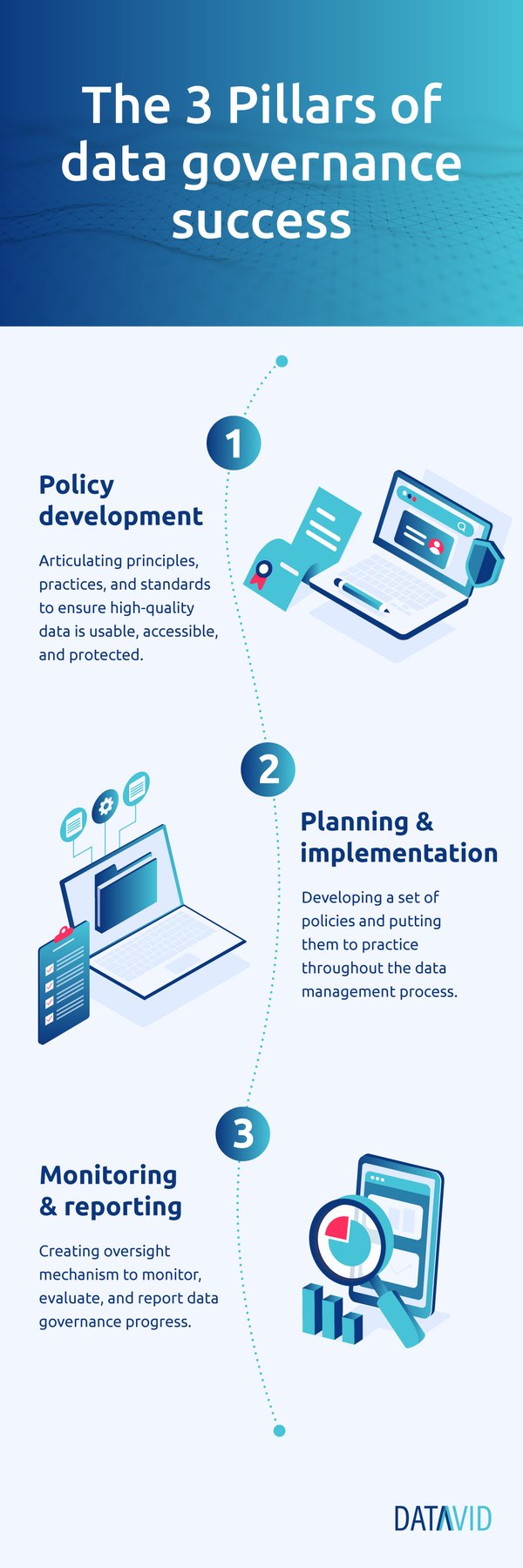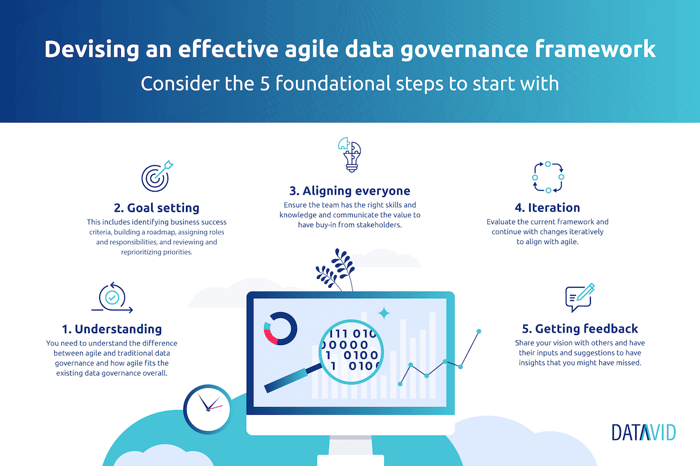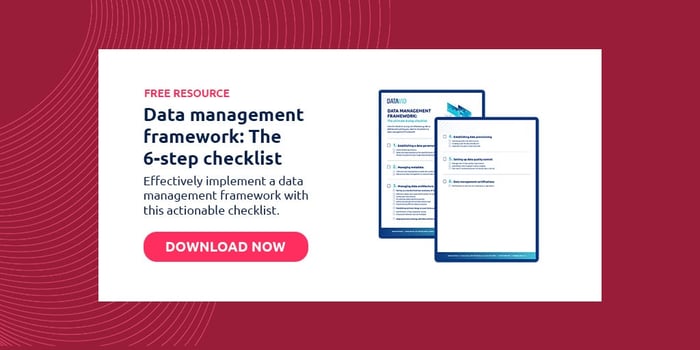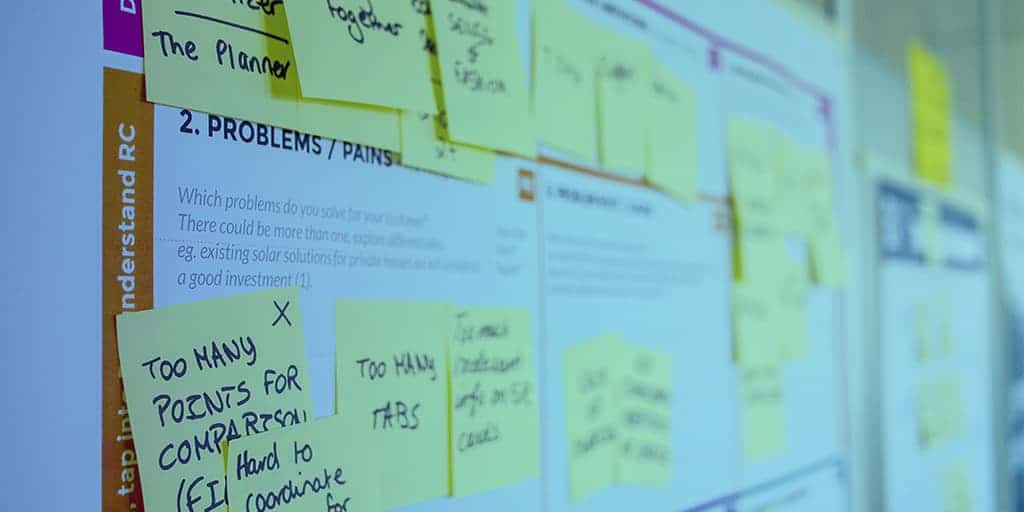6 minute read
Building an agile data governance framework: A complete guide
Agile has been around for a while, but it doesn't apply only to software. Here's an article on agile data governance framework!
Table of contents
Data—in its raw and unfiltered form—isn’t always safe, secure, accurate, compliant, and available when needed.
In other words, it can be a liability if not properly managed. To make the most of your data, applying an agile method to governance is key.
That means defining policies and procedures, monitoring data usage, ensuring compliance with various regulatory entities, and applying changes iteratively.
While this may all seem daunting, there is a tried-and-true system to get started…
What does data governance mean?
Data governance is essentially the process by which organisations manage the availability, integrity, usability, and security of data assets in enterprise systems. It includes everything from planning and policy development to implementation and maintenance.
Data governance ensures that data is used effectively and efficiently while protecting against misuse or loss across the organisation.
Data governance is often confused with information security.
In reality, they are two different things:
- Information security focuses on preventing unauthorised access to data, whereas;
- Data governance focuses on how data gets used by various actors.
For example, an organisation might have a data governance plan that outlines what types of data will be collected, where it will be stored, who has access to it, etc. This ensures that only the right people can access the correct data at the right time.
The 3 key elements of good data governance
A good data governance framework comprises several crucial aspects, but three components in particular demand the most attention:

Element #1: Policy development
Policy development involves creating and maintaining policies that define how data is created, accessed, shared, and destroyed.
As well as who can take certain actions.
These policies are written as part of a larger data strategy document. They outline the rules and regulations that govern how data is handled within an organisation.
For example, policies may include items like:
- Who owns the data?
- Who has permission to change it?
- What type of data is allowed?
- How long do I keep it?
- Where do I store it?
- Who gets access to it?
- When do I delete it?
Ideally, these questions aren’t just answered on a Word file but embedded within an ERP system or data platform with granular permissions that fit the enterprise’s needs.
Element #2: Planning and implementation
Planning and implementation cover the actual processes involved in implementing data governance.
A typical data governance plan would include developing a set of policies and then implementing them through various deployment stages.
Some common phases include:
- Data collection
- Data storage
- Data sharing
- Data analysis
- Data archiving
Once again, most of these can be achieved with a data platform like Datavid Rover, where all your enterprise data comes together to tell a unified story.
Element #3: Monitoring and reporting
Monitoring and reporting refer to the ongoing monitoring and evaluation of data governance activities.
You can do it manually or automatically using software tools.
However, an effective data governance program requires regular review and adjustment to ensure that all policies are followed.
For example, suppose a company collects customer data.
In that case, it needs to know whether this data is being adequately secured, who has access to it, and when they should delete it.
This kind of oversight helps companies avoid costly mistakes and protect themselves from potential legal liabilities.
Can agile apply to data governance?
In a word, yes! Agile methods are ideal for managing data because they allow teams to collaborate closely to create value.
Here are some ways that Agile can help:
- Agile allows you to build a flexible system that adapts to changing requirements. You can easily add new features without having to rewrite existing code.
- It encourages collaboration among team members. As a result, everyone on the data project works together to solve problems and improve their skills.
- Promoting transparency provides visibility into progress and status.
- Agile encourages continuous improvement by allowing teams to identify and fix issues quickly before they become big problems.
- It provides flexibility by allowing teams to choose their own approach to solving problems.
- It also promotes experimentation by encouraging teams to try new ideas and learn from experience.
There are many additional benefits, but consider the ones above the key outcomes of a successful data governance framework that leverages agile.
5 steps to an agile data governance framework
The most effective agile data governance framework comprises five foundational stages.
The best part is that each stage is tailor-made to build off the previous, ensuring that your data governance program grows in value over time.

Step 1: Understand agile & data governance separately
Your first assignment is to ensure you understand how agile applies to data governance.
It helps you decide whether agile is a good fit for your organization and, if so, which parts of your current data governance process could benefit from agile.
To do this, ask yourself these questions:
- Do I already use agile methods for other aspects of my business? If yes, does that mean I’m already familiar with its principles?
- Does my data governance program follow any particular methodology? If not, would it make sense to adopt one?
- What are the key differences between agile and traditional data governance processes?
While agile methods are based on 4 core principles, the idea is to build an extension of them as part of your internal culture to extract the most value from each session.
Step 2: Set clear expectations and outcomes
Once you know where you stand regarding agile and data governance, it’s time to integrate them and set clear-cut goals. This step includes defining success for both agile and data management.
You also want to define the roles and responsibilities of everyone involved.
If you’re going to achieve your monthly, quarterly, and annual targets, you must implement airtight strategies to support this ambition.
These include:
- Identifying business success criteria. What will it take to hit those numbers? For example, what metrics should you track if you want to increase your customer retention rate by 10%?
- Building your roadmap. How will you get there? Do you need to change anything in your current data governance program?
- Reviewing and reprioritising your priorities. Are there any projects that aren’t getting enough attention? Which ones should you focus on more?
Check back on these often; don’t let them sit in a Google document untouched for months. Without consistent reviews, people can lose track of the higher-level goal.
Step 3: Make sure all stakeholders are ready to switch gears
The third step involves ensuring people embrace agile within the company culture.
If you’ve already decided it’s the right way to move forward, make sure you spend time educating people on what’s going to change and what’ll stay the same:
- Make sure your team has the right skills. They need to be able to work effectively in an agile environment.
- Ensure your team members have the necessary knowledge to deliver on their tasks.
- Communicate the value of agile data governance. Explain how it can help your company meet its objectives.
- Get buy-in from all stakeholders. Ensure they understand the importance of agile data governance.
Agile is a matter of people and collaboration above all, so it won’t be beneficial to skip this step and get to implementing the processes without telling anyone.
Step 4: Make iterative changes to existing frameworks (or create a new one)
The fourth step is to assess your current framework and determine whether it makes sense to continue using it.
If your current framework doesn’t align with Agile, you may need to replace it altogether or make significant changes to it.
For example, if your current data governance program lacks transparency, you might add a dashboard to show stakeholders how well each project is progressing.
Or, if you don’t have a formal approval process, you might introduce a simple review board.
If you feel that your current framework works fine but still want to improve it, you should consider creating a new one.
And if you decide to start from scratch, you’ll need to develop a new framework that fits your organisational needs and ambitions.
Step 5: Get feedback and create a backlog of issues to approach
Once you’ve completed all four steps, you can implement your agile data governance program! But before you dive in, take a moment to think about what you’d like to see happen next.
- What would you like to learn more about?
- What would you like to change?
These questions will help guide your efforts.
Now that you know what you want to achieve, it’s time to share your vision.
Start by sharing your ideas with your team members and managers. Ask them to give their input and suggestions; they may offer insights that you hadn’t considered.
Next, ask your customers and users what they think.
Do they agree with your proposed improvements?
Are there any other areas for improvement?
Make your data governance more agile today
Hopefully, this guide on agile data governance has helped you better understand the concept and provided a roadmap for getting started.
We hope you find this resource useful, whether you want to make small changes or embark on an ambitious project.
And if you need additional guidance, Datavid is here to help.

As a data consulting company that delivered 30+ successful, large-scale data projects between 2020 and 2023, Datavid can help you make the right data decisions. Both from a business and a technical standpoint.
Implementing a good data governance framework means investing in years of successful delivery and increasing exclusive value for your enterprise. Take the first step!
Frequently Asked Questions
What is the agile approach to data governance?
The agile approach to data governance emphasises flexibility, collaboration, and iterative processes to effectively manage data assets. It involves adopting agile principles and practices, such as cross-functional teams, incremental development, and continuous feedback, to address data governance challenges in a more adaptive and responsive manner. It focuses on enabling quick iterations, fostering collaboration between business and IT stakeholders, and delivering tangible value through data governance initiatives.
What are examples of data governance?
Examples of data governance include data stewardship, data standards and policies, data documentation, data quality management, data access and security, data lifecycle management, data governance committees, data compliance and regulatory alignment, data governance tools, and data governance maturity assessment.
What are the 4 pillars of data governance?
The four pillars of data governance are data ownership, data standards and policies, data processes and controls, and data governance framework.





